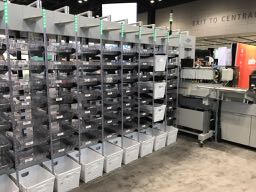 Last week in Chicago I got to look at a range of online fulfilment solutions. The most interesting were the fully automated facilities aimed at small operations.
Last week in Chicago I got to look at a range of online fulfilment solutions. The most interesting were the fully automated facilities aimed at small operations.
Whereas in the past it cost hundreds of thousands of dollars to establish an automated warehouse for even 500 items, today that can be done for under ten thousand dollars.
The photo shows a small part of one such facility I saw up and running. It picks goods, feeds them to a packing line where they are packed, sealed and labelled ready for collection. Hands free.
These facilities run with a considerably lower labour cost that our small businesses that fulfil for online sales. It is a way tech engaged online competitors are able to sell at lower costs, they have lower overheads.
While there is plenty of discussion abut websites we can see, there is little written about the back end, the fulfilment side of things, where tremendous advances have been made in delivering access to solutions with considerably lower cost that has been the case.
I spent two and a half days diving deep into this side of online retail, looking at many different fulfilment options from the tech-centric to low-tech and highly personal. It was fascinating and illuminating given the moves Amazon is just months away from making in Australia.
The start-up costs for a pure online retail play have never been lower. This low barrier to entry and the flexibility of a start-up compared to a legacy business like then traditional newsagency presents challenges we need to confront. That starts with awareness. hence this post.
2017 is not even half over yet and it has already delivered more innovation around online and fulfilment than the last two or three years combined, innovation that is cost effective for small businesses and start-up businesses.
Now, if you think this is not relevant to you, I say it is as even today there are online businesses taking revenue from you, delivering to people who are local to you.
I have evidence of businesses, for example, in Western Australia, taking revenue from local high street businesses in suburban Sydney. People purchasing online worry less about local and more about the brands they purchase.